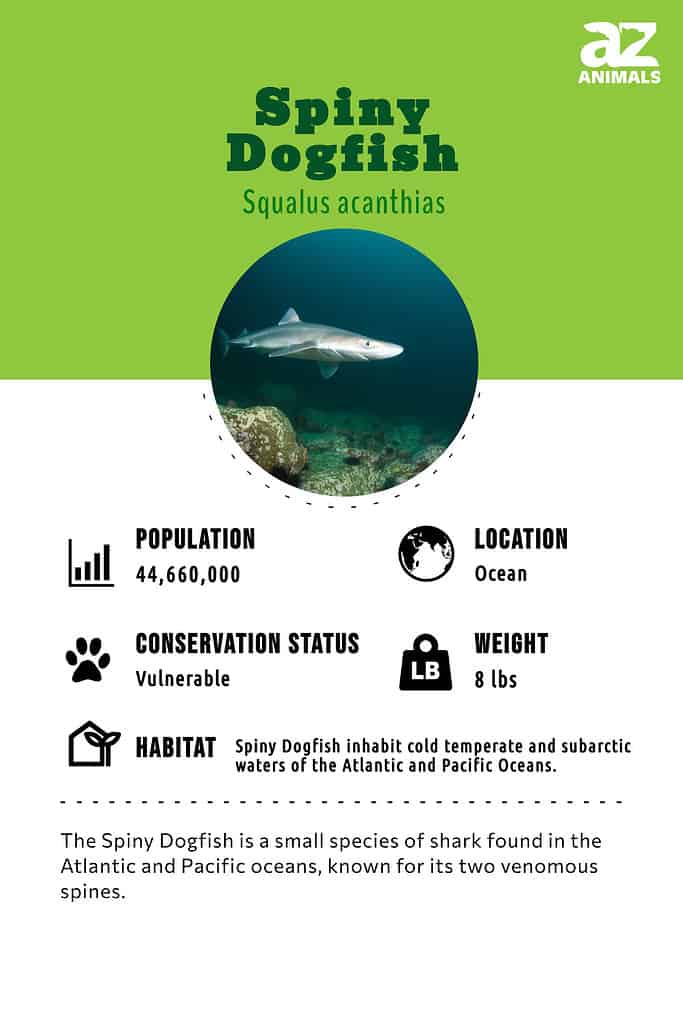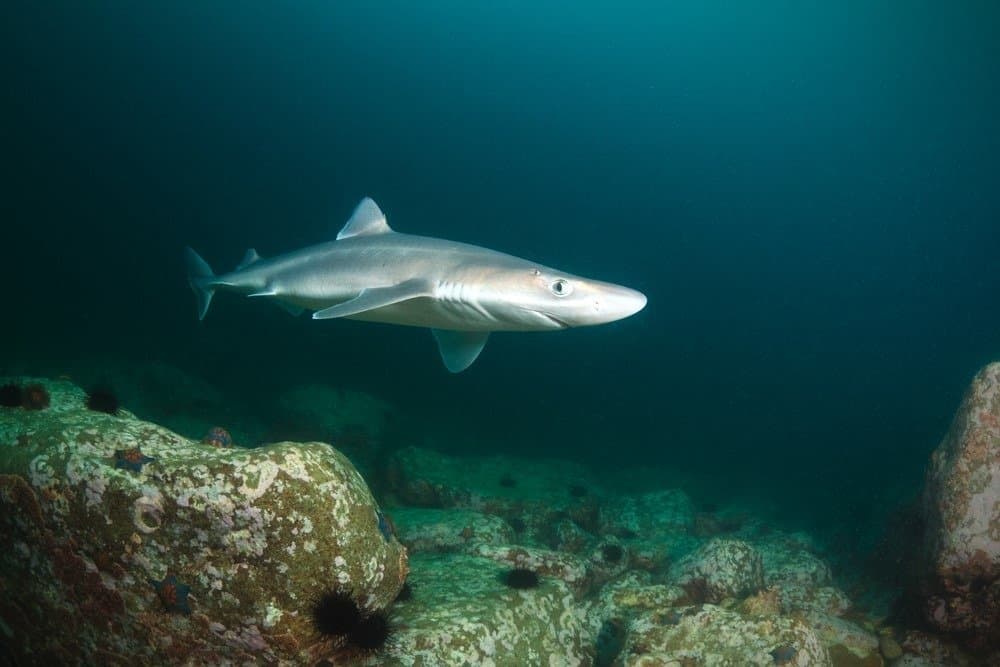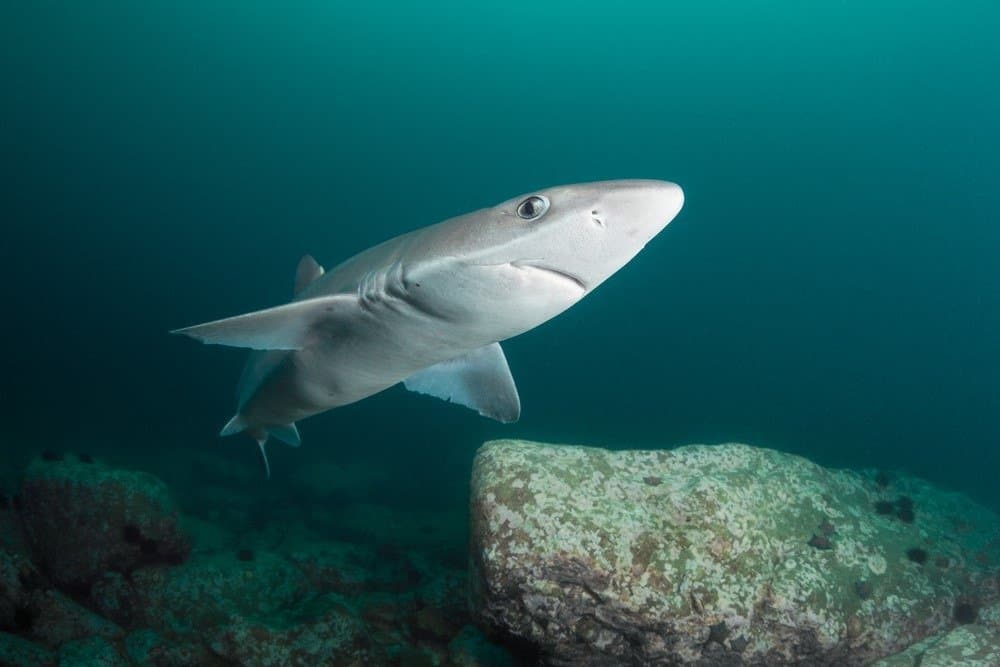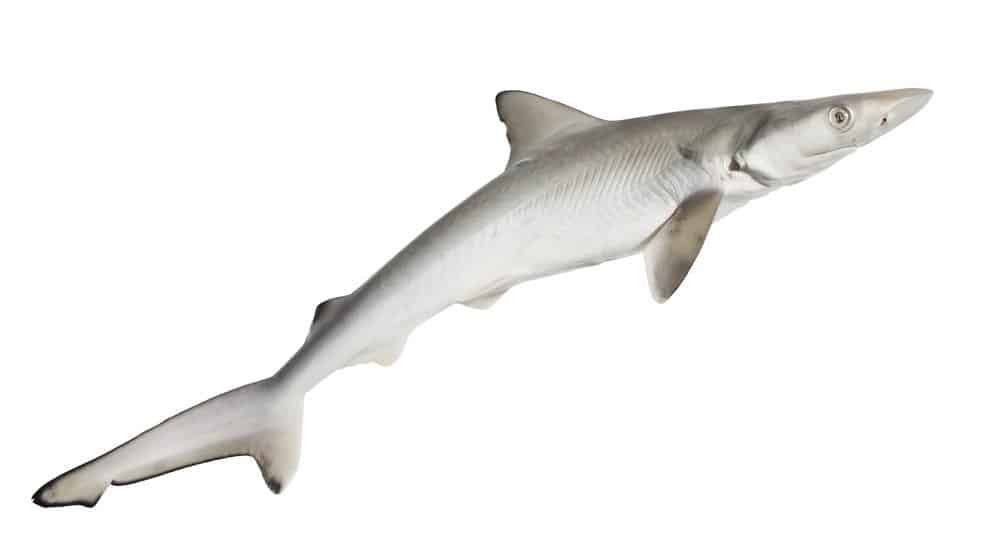Spiny Dogfish
Squalus acanthias
Before overfishing, the Spiny Dogfish was the most abundant spark species in the world.
Advertisement
Spiny Dogfish Scientific Classification
- Kingdom
- Animalia
- Phylum
- Chordata
- Class
- Chondrichthyes
- Order
- Squaliformes
- Family
- Squalidae
- Genus
- Squalus
- Scientific Name
- Squalus acanthias
Read our Complete Guide to Classification of Animals.
Spiny Dogfish Conservation Status
Spiny Dogfish Facts
- Prey
- Octopuses, crabs, squid, smaller sharks, jellyfish, shrimp, and sea cucumber
- Main Prey
- Fish, Squid, Crustaceans
- Group Behavior
- Pack
- Fun Fact
- Before overfishing, the Spiny Dogfish was the most abundant spark species in the world.
- Estimated Population Size
- Biomass of 106.8 thousand metric tons in the Atlantic Ocean; 44,660,000 fish in the Pacific Ocean
- Biggest Threat
- Overfishing
- Other Name(s)
- Dogfish Shark, Spiky Dog, Piked Dogfish, Rock Salmon, Spring Dogfish, White-Spotted Dogfish Predators: Sharks, Seals, Orcas, Tuna, American Anglerfish, Humans
- Optimum pH Level
- 6.5-8.5
- Habitat
- Oceans and seas
- Predators
- Sharks, Whales, Humans
- Diet
- Carnivore
- Favorite Food
- Octopuses, crabs, squid, smaller sharks, jellyfish, shrimp, and sea cucumber
- Common Name
- Spiny Dogfish
- Number Of Species
- 2
- Average Clutch Size
- 6
- Slogan
- Found in ocean waters worldwide!
View all of the Spiny Dogfish images!

The Spiny Dogfish is a smaller shark that is found in both the Atlantic and Pacific Oceans.
They prefer a saltwater habitat but may enter brackish water. Spiny Dogfish are unique in that they have two spines. If they are attacked, they will use these two spines to arch their backs and inject poison into their attacker.
Some other key characteristics of a Dogfish include the white spots on their side, large eyes, and the brownish/grayish coloring on their top that fades to a white belly.
Incredible Spiny Dogfish Facts!

The Dogfish possesses a pair of spines that it can use to inject venom into predators when threatened, by arching its back.
©Doug Costa – Public Domain
- The Dogfish has two spines. If they are attacked, they can arch their back and inject venom into their attacker.
- These sharks have the longest gestation period of any vertebrate at about two years.
- A Dogfish may live up to 50 years, but most will live between 20 and 24 years.
- When catching prey, a Dogfish may use its pointier nose to ram its prey.
- This species can sense an electric field generates by its prey, which helps them when hunting.
Classification and Scientific Name

The sharks commonly known as dogfish have a scientific name of Squalus acanthias.
©Boris Pamikov/Shutterstock.com
The scientific name for these sharks is Squalus acanthias. Squalus comes from the Latin word for shark and Acanthias is derived from the Greek word akanthias which refers to the spines of a Spiny Dogfish.
The Spiny Dogfish is also known by many other names including piked dogfish, spiky dog, and rock salmon. It belongs to the Squalidae family and is in the Chondrichthyes class. There are 40 different species in the Squalidae family.
Recently, scientists determined that the Spiny Dogfish that live in the northern Pacific Ocean were a separate species. This species is called the Pacific Spiny Dogfish. Its scientific name is Squalus suckleyi.
Different Types
- Pacific spiny dogfish
- Longnose spurdog
- Shortspine spurdog
- Shortnose spurdog
- Cuban dogfish
- Japanese spurdog
- Blacktailed spurdog
- Cyrano spurdog
- Squalus acutirostris
- Eastern highfin spurdog
Appearance

Compared to other shark species, the Spiny Dogfish, also known as Dogfish Shark, is relatively small.
©Joern_k/Shutterstock.com
The Spiny Dogfish, or Dogfish Shark, is smaller than many other species of sharks. A male’s body has a maximum length of 39 inches, and a female’s body has a maximum length of 49 inches. Most of them weigh around 8 pounds.
These sharks have a very slender body with a pointy snout and large eyes. A Spiny Dogfish’s skin is darker on the top and fades to white or pale color on the belly.
The skin is a brown or gray along the top of the body. Another one of the key characteristic of them is the small white spots that go along the sides of their body. As a Spiny Dogfish ages, these spots will begin to fade.
Spiny Dogfish have two spines that they use for self-defense. If they get captured, they will arch their back and use the spines near their dorsal fin to pierce the predator and secret venom into them.
Distribution, Population, and Habitat

The Spiny Dogfish, or Dogfish Shark, is distributed in the Atlantic and Pacific Oceans; however, the Pacific Spiny Dogfish has recently been recognized as a distinct species.
©Boris Pamikov/Shutterstock.com
These sharks are found in the Atlantic and Pacific Oceans. Recently, the Spiny Dogfish in the Pacific Ocean were determined to be a separate species and were given the name Pacific Spiny Dogfish.
In the Atlantic Ocean, they are found between Greenland and Argentina on the western side of the ocean. They can also be found in the eastern Atlantic Ocean between Iceland/the Murmansk Coast down to South Africa. These sharks are also found in the Black Sea and the Mediterranean Sea. The Pacific Spiny Dogfish can be found in the Pacific Ocean between the Bering Sea and Baja California.
These sharks may swim both inshore and offshore over the continental shelf. They prefer to swim in saltwater, but they may enter brackish water at times. They cannot be found in freshwater, however. Most of the time, Spiny Dogfish prefer to swim at depths between 160 and 490 feet beneath the surface. Though, they may venture as deep as 2,300 feet beneath the surface at times.
This shark population has seen a big decrease over the years. At one time, they were the most abundant species of sharks, but now the International Union for Conservation of Nature has given them a classification as vulnerable globally and critically endangered in the northeast section of the Atlantic Ocean.
In 2010, it was estimated that these sharks have a total biomass of 106.8 thousand metric tons in the Atlantic Ocean and that there were about 44,660,000 fish in the Pacific Ocean.
Predators and Prey
What Threatens the Spiny Dogfish?
There are a few natural predators that threaten these sharks. These include Killer Whales, Seals, large sharks, Tuna, and American Anglerfish. When attacked, the Dogfish will try to protect itself by arching its back and using its dorsal spines to inject venom into its attacker.
Humans also pose a threat to the Dogfish. Overfishing by humans has led to a significant decrease in the population of Spiny Dogfish. One of the reasons they are so impacted by fishing is that this species has a longer gestation period than many other species of fish and have smaller litters of young.
It also takes females longer to reach sexual maturity, which makes it harder for the population to grow quickly. The sharp decrease in their numbers in the past years has led to them being classified as vulnerable by the International Union for Conservation of Nature.
What do Spiny Dogfish Eat?
These sharks often hunt for food in a larger pack of up to 1,000 Dogfish. They eat octopuses, crabs, squid, smaller sharks, jellyfish, shrimp, and sea cucumbers. They use their very strong jaws and sharp teeth to bite their prey. It is believed that they consume less food during winter when they spend more time in deeper water. During the spring and summer months, they swim towards the coasts where it is warmer, and they can find more food.
Reproduction and Lifespan

The spiny dogfish isolated on white background
©IrinaK/Shutterstock.com
Males reach the age of sexual maturity around the age of 11 years, and females reach the age of sexual maturity by the time they are 12 or 14 years old. Mating normally takes place in offshore waters with internal fertilization.
After fertilization, a hard shell forms around the embryos to keep them protected. This shell will shed off after four to six months, but the young fish will continue to gestate for 18 to 20 more months. This means that the total gestation period for the Spiny Dogfish is about 2 years, the longest of any vertebrate.
On average, six pups are born in each litter. There could be as few as two pups or as many as 11 pups in each litter, though. The pups are between 20 and 33 centimeters long when they are born. Nearly right away, Spiny Dogfish will begin hunting for food. They may even start hunting food that is more than twice their size.
The lifespan of these sharks is typically between 20 and 24 years, but there have been some that lived to be 50 years old.
Fishing and Cooking
These sharks are fished both commercially and recreationally. Their meat is particularly popular in France, Italy, Germany, England, and other European countries. Though, they are also eaten in the United States, Chile, Canada, New Zealand, and other places around the globe.
In Chinese cuisine, they are used to make fin needles as an alternative to shark fin soup. The fins and tails of these sharks are used to make these fin needles. Spiny Dogfish are sold as “huss” in England, “small salmon” in France, and “sea eel” in Germany and Belgium.
Here are a few recipes that use Spiny Dogfish:
• Pan-Seared Spiny Dogfish
• Spiny Dogfish Tacos
• Pan Blackened Spiny Dogfish with Pico de Gallo
Spiny Dogfish FAQs (Frequently Asked Questions)
Where are Spiny Dogfish found?
Spiny Dogfish are located in the Atlantic and Pacific Oceans. In the Atlantic Ocean, they are spread out between Greenland and Argentina on the west side and Iceland and South Africa on the east side. They range from the Bearing Sea to New Zealand in the western Pacific Ocean and the Bearing Sea to Chile in the eastern Pacific Ocean.
What is a Spiny Dogfish?
A Spiny Dogfish is part of the Dogfish (Squalidae) family of sharks. They are a small shark with a few key characteristics, such as their two spines and white spots on the sides of their body. If attacked by a predator, a Spiny Dogfish will arch its back and inject venom into their attacker.
What do Spiny Dogfish eat?
Spiny Dogfish eat crabs, squid, octopuses, jellyfish, smaller sharks, sea cucumbers, and shrimp.
What is the scientific name of the Spiny Dogfish?
The scientific name for the Spiny Dogfish is Squalus Acanthias.
What does Spiny Dogfish taste like?
Spiny Dogfish is a relatively mild-flavored fish. It is sweeter than some other fish and is oilier than mako sharks and other shark meat options. The fish is relatively firm, yet flaky when cooked. Spiny Dogfish is featured in a variety of different cuisines. It is known as sea eel in Germany and Belgium, small salmon in France, and huss in England. In China, the fins and tails are sometimes used to make fin needles for a cheaper version of shark fin soup.
How big do Spiny Dogfish get?
Spiny Dogfish weighs around 8 pounds. Females have a maximum length of 49 inches and males have a maximum length of 39 inches.
What Kingdom do Spiny Dogfish belong to?
Spiny Dogfish belong to the Kingdom Animalia.
What class do Spiny Dogfish belong to?
Spiny Dogfish belong to the class Chondrichthyes.
What phylum to Spiny Dogfish belong to?
Spiny Dogfish belong to the phylum Chordata.
What family do Spiny Dogfish belong to?
Spiny Dogfish belong to the family Squalidae.
What order do Spiny Dogfish belong to?
Spiny Dogfish belong to the order Squaliformes.
What genus do Spiny Dogfish belong to?
Spiny Dogfish belong to the genus Squalus.
What type of covering do Spiny Dogfish have?
Spiny Dogfish are covered in Smooth skin.
What are some predators of Spiny Dogfish?
Predators of Spiny Dogfish include sharks, whales, and humans.
How many eggs do Spiny Dogfish lay?
Spiny Dogfish typically lay 6 eggs.
What is an interesting fact about Spiny Dogfish?
Spiny Dogfish are found in ocean waters worldwide!
What is a distinguishing feature of the Spiny Dogfish?
Spiny Dogfish have two spines.
How many species of Spiny Dogfish are there?
There are 2 species of Spiny Dogfish.
What is the biggest threat to the Spiny Dogfish?
The biggest threat to the Spiny Dogfish is overfishing.
What is the optimal pH for a Spiny Dogfish?
The optimal pH for a Spiny Dogfish is between 6.5 and 8.5.
What is another name for the Spiny Dogfish?
The Spiny Dogfish is also called the dogfish shark, spiky dog, piked dogfish, rock salmon, spring dogfish, or white-spotted dogfish.
How many Spiny Dogfish are left in the world?
There are approximately 106.8 thousand metric tons of Spiny Dogfish in the Atlantic Ocean, and approximately 44,660,000 Spiny Dogfish in the Pacific Ocean.
Thank you for reading! Have some feedback for us? Contact the AZ Animals editorial team.
Sources
- David Burnie, Dorling Kindersley (2011) Animal, The Definitive Visual Guide To The World's Wildlife
- Tom Jackson, Lorenz Books (2007) The World Encyclopedia Of Animals
- David Burnie, Kingfisher (2011) The Kingfisher Animal Encyclopedia
- Richard Mackay, University of California Press (2009) The Atlas Of Endangered Species
- David Burnie, Dorling Kindersley (2008) Illustrated Encyclopedia Of Animals
- Dorling Kindersley (2006) Dorling Kindersley Encyclopedia Of Animals
- Wikipedia, Available here: https://en.wikipedia.org/wiki/Spiny_dogfish
- Oceana, Available here: https://oceana.org/marine-life/sharks-rays/spiny-dogfish
- Fishbase, Available here: https://www.fishbase.de/summary/139#:~:text=Etymology%3A%20Squalus%3A%20Genus%20name%20from,6885%2C%2027436).
- Florida Museum, Available here: https://www.floridamuseum.ufl.edu/discover-fish/species-profiles/squalus-acanthias/
- Chesapeake Bay Program, Available here: https://www.chesapeakebay.net/discover/field-guide/entry/spiny_dogfish#:~:text=Appearance,grey%20backs%20and%20white%20bellies.

















